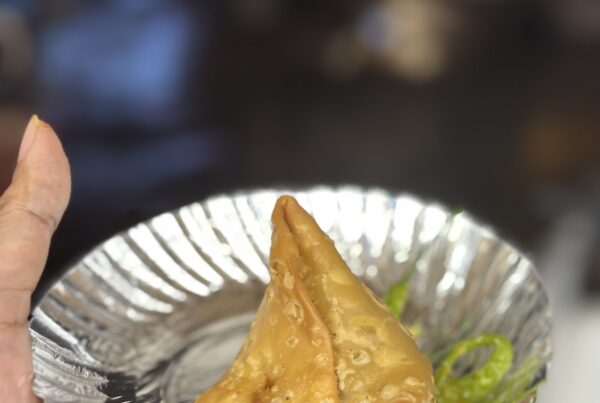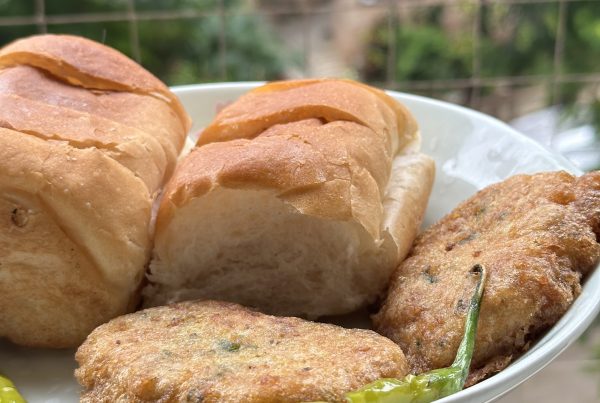 |
| Lunch today: Bhindi fry, tur dal, mirchi achar, multigrain roti. Good stuff. |
What was my lunch today? Bhindi fry, tur dal, multi grain roti with ghee.
Dinner? Pabda maccher jhol and bhaat.
As everyday food as it gets. The perfect fuel for writing this article as you will see.
Kishwar Chowdhury, finalist in the latest edition of the Masterchef Australia, made a dish called smoked water rice in the finals. A dish inspired by the panta bhaat of Bangladesh and Bengal. She did not win the finals but did create a bit of a stir on both side of the Padma with her dish.
It has been a few years since I stopped watching Masterchef Australia and this was before they had changed their judges. We used to quite enjoy it initially but then it got a bit too soppy and theatrical for us. I do not know if that has changed. There’s no denying though that the series had played a big role in developing our love for food and for local food at that. The judges would often encourage participants to showcase their native food as far as I remember with a lot of focus on local produce.
This time around some of my Bengali readers on Instagram had excitedly alerted me to Ms Chowdhury’s presenting dishes from the Bengali pantheon in the contest and I began following her on Instagram. Then the final happened and I saw some chatter around her presenting panta bhaat (bhat). My childhood friend from Kolkata sent an e-article on the same. I could sense the joy, wonder and the indulgent smile which accompanied his message.
Let me explain why I say so. Panta bhaat is among the most basic of everyday meals in Bengal. Possibly of rural origins. While we knew of the dish while growing up in Kolkata in the 80s, we had not really come across it. It was not made in our house or in those of my friends. A function of socio-economics perhaps as we all came from middle class families exposed to an English education. My grandparents used to tell me a folk tale where panta bhaat featured. My mum tells me it’s possibly the story of the tuntuni paakhi (bird). (Update: My mother shared her blog post where she had documented the story. It is of the panta buri and not tuntni)
I confess that I am yet to have panta bhaat. I have had the Odia rendition of it, pakhala bhaat, thanks to home chefs such as Ananya Banerjee (who is Bengali) and Sneha Senapati (who is Odia) in Mumbai. The Bombay Canteen offered it during their Odia food festival but I tried other dishes from the menu when I went there and skipped the PB. A couple of years back, I had the pazham kanji, the Kerala version of panta bhaat, at the Grand Hyatt, Kochi. I was impressed to see such a simple dish being proudly presented in such a majestic luxury hotel.
 |
| Pazham kanji, Grand Hyatt, Kochi |
I must say that I have unabashedly enjoyed each of these experiences. The clean flavours, the peaceful easy feel that comes with each mouthful, the interplay of condiments such as green chillies, shallots, pickles, mustard, fried anchovies, with the tartness of the fermented rice gruel, is rather symphonic and unforgettable.
I recently learnt from my dear friend and food enthusiast, Kaniska Chakraborty, that panta bhaat enjoys its pride of place on the other side of the border. That the everyday meal of panta bhaat, combined with the much revered ilish maachh (hilsa), is the meal of choice across Dhaka on pohela boishakh. The day the Bengali new year is celebrated in Bangladesh. One can argue that given that the nation state of Bangladesh was formed on the demand of right to freedom of language, the emphasis on all things Bangla, is a bit more amplified there than in India where Bengal is one of the 29 states and 7 union territories that form our country.
Food writer, dieticians and bloggers, who have been championing the cause of Indian food in recent years, have spoken about the benefits of fermentation in our food. The panta bhaat is as an example of this.
I must admit that I am someone who lives under a rock with my two cats. It is only when I saw an Instagram story by Sangeeta Khanna, tagging an Indian Express article by Pooja Pillai on the topic, that I realised that there had been fair amount of derisive banter on Chowdhury’s presenting panta bhaat in the finals.
“How can you showcase something so plebeian at so grand a platform,” seemed to be general refrain.
I thought back to some of the tweets I saw referring to this issue yesterday, and my subsequent Twitter chat with Gaurav Sabnis and Kaniska on the matter, and began to get a sense of the discourse that have emerged. When I asked K about it, she did say that say that she saw some memes mocking the fact that leftovers had stolen the show.
I obviously have expunged most controversy seeking folks from my feed as had I missed all of this!
My point here is not about panta bhaat. I am no expert on it as you must have guessed by now.
As I wryly said while posting a picture of the same on Instagram yesterday, Hakka noodles is my panta bhaat. Comfort food.
To know more about panta bhaat you are better off reading what Sangeeta Khanna had written about fermented foods. Or a post Debjani Chatterjee Alam wrote after the incident where she explains what panta bhaat is and how to make it.
My point is simple:
If we do not glorify our food, mundane or majestic, then who will?
Look at what people across the world have done.
The Japanese have created such reverence over sushi. Well during the Edo period, the nigiri sushi was offered on the streets around the port in Tokyo to fisher folks, with vinegar being used to ensure that the fish stays fresh. A bit like how bits and pieces of vegetables were used to create pav bhaaji to satisfy the hunger pangs of traders outside the Cotton Exchange in Mumbai. Sushi was sold from street corner stalls in Tokyo then, just as the vada pav is in Mumbai today.
If you think of the pho of Vietnam, the laksa of Malaysia and the Khow Suey of Burma, you think of posh restaurants that offer them, glossy recipe books that deconstruct them and beautiful food origin documentaries starring them which make you wish to go to those countries to experience them. When you go there, you will see that they are often served out of carts similar to those hawking jhal muri in Kolkata or eateries as basic as the nihari joints of purani Delhi. Ditto with the mezze platter which we go to trendy cafes to eat. Very much a part of the street food culture of the middle east. The list of everyday dishes becoming epic internationally is endless.
The people in these countries showed an infectious pride and love in what they eat, making these dishes legends across the world in the process.
I think it is time we do the same for our food instead of revelling in sarcasm, bitterness and mockery.
 |
| Pabda maccher jhol. Dinner tonight. |
Having said that, I must say that there are many wonderful veteran food writers and bloggers, young social media enthusiasts, TV, restaurant and home chefs, dieticians, restaurateurs, etc, who are all contributing to creating pride in what we eat.
I am pretty sure that the glory days of the food of the Indian subcontinent are coming round the corner.
Thanks for reading and would love to hear your thoughts on this.
Appendix:
Chat with Kaniska on Poila Boishakh
Pazham kanji at Gran Hyatt Kochi
Sangeeta Khanna on panta bhaat
Article on @zeezest site.







